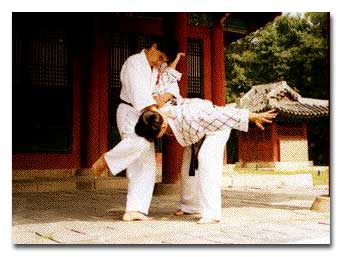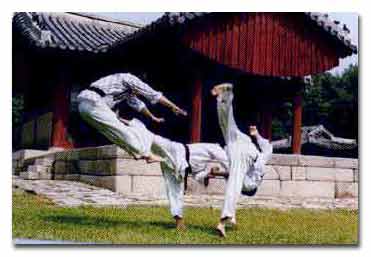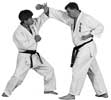Hapkido
..................................![]() Overview
Overview
![]() PKG Tours
PKG Tours
![]() Video Clips
Video Clips
..................................
![]()
Jeju Championship

¢Ñ What is? | ¢Ñ Origin | ¢Ñ History
 All people
have "KEE(vigor,Ѩ )" or energy rooted in
the breath. So deep breathing exercise are a vital part of HAPKIDO.
They make us stronger in body and spirit, helping to protect us
not only from attackers but from poisonous thinking. In this way,
HAPKIDO serves universal harmony.
All people
have "KEE(vigor,Ѩ )" or energy rooted in
the breath. So deep breathing exercise are a vital part of HAPKIDO.
They make us stronger in body and spirit, helping to protect us
not only from attackers but from poisonous thinking. In this way,
HAPKIDO serves universal harmony.
HAPKIDO is your "KEE(vigor,Ѩ )"
all other peoples "KEE(vigor,Ѩ
)"s, The
proforned of nature and the solid earth all in harmony. When you
attacket's power against him.
HAPKIDO is not just for the strong.
Women, children and the elder can also train because HAPKIDO is
a natural martial arts.
Hap Ki Do is a discipline of coordination, a way of strengthening the mind and body, of fusing the individuals physical and mental powers so that he or she will emerge as a more fully integrated human being. The word in fact means; Method or Way (DO) for the coordination Harmony (HAP) of mental Energy or spirit (KI). One should always try to avoid violence, but if someone grabs you, attempts to strike you, or physically assaults you in any way, it has escalated beyond words, and you are left with the only option which is to defend.
The Korean Art of Self Defense, Hap Ki Do is considered a "soft" style of Martial Art, as opposed to "hard" styles that practice the use of force against force, making the outcome a simple matter of size and strength. The Hap Ki Do practitioner diverts or suppresses an attacker's flow of energy peacefully, this diversion allows him to use the attackers power against himself leading to the attackers defeat. Through the use of pressure on certain skeletal joints and pressure points, very little strength is needed to overcome an opponent.
PKG TOURS
 Hap Ki Do not only redirects the attack,
but turns it back against the attacker and follows through with
offensive techniques which may control his violence or render him
incapable of further antagonistic actions. The Hap Ki Do practitioner
is in complete control of the confrontation defusing the aggression
without the need for uncontrolled damage as seen in many "hard"
styles.
Hap Ki Do not only redirects the attack,
but turns it back against the attacker and follows through with
offensive techniques which may control his violence or render him
incapable of further antagonistic actions. The Hap Ki Do practitioner
is in complete control of the confrontation defusing the aggression
without the need for uncontrolled damage as seen in many "hard"
styles.
Hap Ki Do provides complete physical conditioning
which improves balance, posture, flexibility, timing, quickness,
muscle tone, joint strength and most importantly, confidence through
physical and mental discipline.
The immediate aim of Hap Ki Do is of course
the welfare of the one practicing it. Not only will skills in self-defense
be attained, but more importantly will be the focus on an individuals
character development. A well rounded personality can be realized
only if the spirit is right. Courtesy, Respect, Modesty, Loyalty,
Generosity, and Dedication are not only the source, but also the
rewards of Hap Ki Do.
 The
origin of Hapkido is the subject of some controversy. Some sources
say that the founder of Hapkido, Choi, Yong Sul was a houseboy/servant
(some Hapkido history even say "the adopted son") of Japanese
Daito Ryu Aikijujutsu Grand Master Takeda, Sokaku. In Japan, Choi
used the Japanese name Yoshida, Tatsujutsu since all immigrants
to Japan took Japanese names at that time. Choi's Japanese name
has also been given as Asao, Yoshida by some sources. According
to this view, Choi studied under Takeda in Japan from 1913, when
he was aged 9, until Takeda died in 1943. However, Daito Ryu records
do not reflect this, so hard confirmation has not been available.
Some claim that Choi's Daito Ryu training was limited to attending
seminars.
The
origin of Hapkido is the subject of some controversy. Some sources
say that the founder of Hapkido, Choi, Yong Sul was a houseboy/servant
(some Hapkido history even say "the adopted son") of Japanese
Daito Ryu Aikijujutsu Grand Master Takeda, Sokaku. In Japan, Choi
used the Japanese name Yoshida, Tatsujutsu since all immigrants
to Japan took Japanese names at that time. Choi's Japanese name
has also been given as Asao, Yoshida by some sources. According
to this view, Choi studied under Takeda in Japan from 1913, when
he was aged 9, until Takeda died in 1943. However, Daito Ryu records
do not reflect this, so hard confirmation has not been available.
Some claim that Choi's Daito Ryu training was limited to attending
seminars.
Ueshiba, Morihei, the founder of Aikido, was also a student of Takeda (this is not disputed). Hapkido and Aikido both have significant similarities to Daito Ryu Aikijujutsu, so it would seem that Hapkido's link to it is real, regardless of how and where Choi was trained.
Choi returned to Korea after Takeda's death and began studying Korean martial arts and teaching Yu Sool or Yawara (other names for jujutsu), eventually calling his Gwan ("school") the Hapki Gwan. Ji, Han Jae, began studying under Choi and eventually started his own school, where he taught what he called Hapkido, after the grand master's school. Along the way, Hapkido adopted various techniques from Dang Soo Do, Taekkyon, and other Korean Gwans (schools).
 Korean
sources may tend to emphasize the Korean martial arts lineage of
Hapkido over the Aikijujutsu lineage, with some even omitting the
Aikijujutsu connection. However, as noted above, the connection
can be seen in the techniques.
Korean
sources may tend to emphasize the Korean martial arts lineage of
Hapkido over the Aikijujutsu lineage, with some even omitting the
Aikijujutsu connection. However, as noted above, the connection
can be seen in the techniques.
Ji now calls his system Sin Moo Hapkido. He currently lives and teaches in California, as does another former Choi student, Myung, Kwang Sik, who is Grand Master of the World Hapkido Federation.
Some other Choi Hapkido students are still living. Chang, Chun Il currently resides in NY, and Im, Hyon Soo who lives and teaches in Korea. Both of these men were promoted to 9th dan by Choi. One of the first Hapkido masters to bring the Hapkido Martial art to the western culture was Han, Bong Soo.
In the 1970's and 80's Hapkido martial arts was taught as the style of choice to elite South Korean armed forces units. Later a more advanced style was taught to the Korean Special Forces called Tukong Moosul.
|














